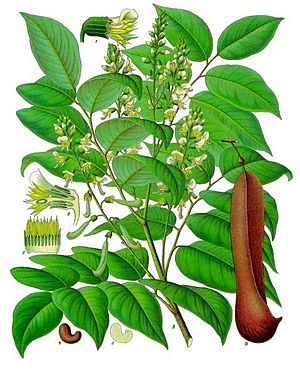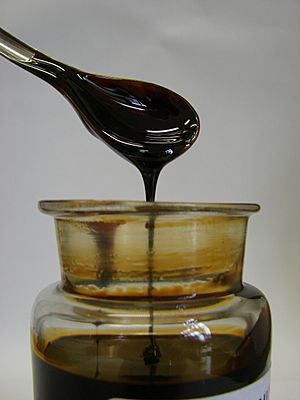Myroxylon balsamum facts for kids
Quick facts for kids Myroxylon balsamum |
|
|---|---|
 |
|
| Tolu balsam tree Myroxylon balsamum var. balsamum |
|
 |
|
| Peru balsam tree Myroxylon balsamum var. pereirae |
|
| Conservation status | |
| Scientific classification | |
| Genus: |
Myroxylon
|
| Species: |
balsamum
|
| Synonyms | |
|
|
Myroxylon balsamum, also known as Santos mahogany, is a type of tree that belongs to the pea family, called Fabaceae. This tree grows naturally in tropical forests. You can find it from Southern Mexico all the way down to the Amazon regions of Peru and Brazil. It usually grows in places that are about 200 to 690 meters (about 650 to 2,260 feet) above sea level. These trees like to grow in soil that drains water well, in forests that are always green and humid.
Tree Varieties
There are two main types, or varieties, of the Myroxylon balsamum tree. These are recognized by the Germplasm Resources Information Network:
- Myroxylon balsamum var. balsamum – This is known as the Tolu balsam tree.
- Myroxylon balsamum var. pereirae – This is known as the Peru balsam tree.
Tree Description
This tree is quite large and grows slowly. It can reach up to 45 meters (about 148 feet) in height. The top part of the tree, called the crown, is round and has many leaves. The bark of the tree is yellowish and has a strong smell.
The leaves grow in a special way. They are made up of smaller leaflets attached to a main stem. Each whole leaf can be 8 to 20 centimeters (about 3 to 8 inches) long. The stems and main parts of the leaves are a bit fuzzy and round. The leaflets are smooth, with edges that are not cut or toothed, and they have tiny dots that produce oil.
The trees start to bloom, or produce flowers, about five years after they are planted from seeds. This usually happens between February and June. The flowers are white and a bit fuzzy, and each flower has about 10 stamens (the parts that produce pollen).
The fruit of the tree is a flat, winged pod. It is shaped like a narrow oval, about 8 centimeters (about 3 inches) long and 1 to 2 centimeters (about 0.4 to 0.8 inches) wide. When the fruit dries, it turns yellow to brown. These pods usually fall from the tree around November to January.
Uses of the Tree
The Myroxylon balsamum tree is famous for its resin, which is used to make two important products: Balsam of Tolu and Balsam of Peru. These balsams are taken from different varieties of the tree in different ways. They are sold to many different people and companies, and then sent to countries like Germany, the United States, England, and Spain.
Once there, these balsams are used to make many things. They are often found in cosmetics like perfumes and soaps. They are also used in medicines, especially for skin problems, and to help with breathing issues like those affecting the lungs and airways. Sometimes, they are even used to help treat burns and wounds. This tree has been planted in places like West Africa, India, and Sri Lanka to produce more balsam.
The wood from the Myroxylon balsamum tree is reddish in color. It has a special pattern because its grain is interlocked, which makes it look like a strong ribbon. When the tree is cut into lumber, it produces a lot of wood without knots. This wood is very hard, with a Janka hardness of 2,200 pounds-force (about 9,800 Newtons). It is also quite good at resisting decay from fungi. Because it is so strong and durable, Myroxylon balsamum wood is used for things like flooring, furniture, indoor decorations, and in heavy construction projects.
Sometimes, Myroxylon balsamum trees are also planted in coffee farms. They are used as shade trees, which means they provide shade for the coffee plants growing below them.
Images for kids
See also
 In Spanish: Myroxylon balsamum para niños
In Spanish: Myroxylon balsamum para niños








